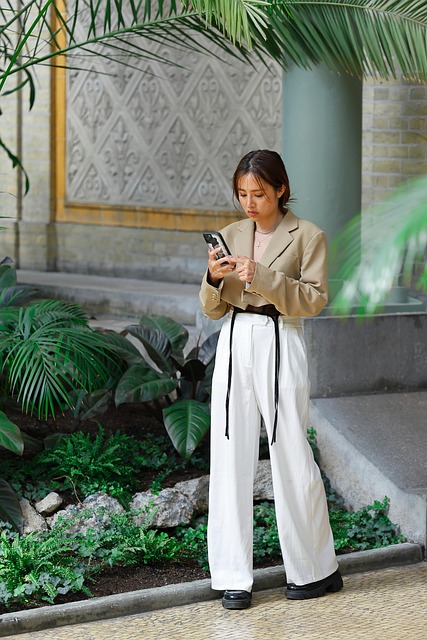Plants in interior design enhance air quality by absorbing pollutants and improve well-being through ambiance, but require strategic placement considering light, airflow, space, and care needs for optimal filtration and aesthetic harmony. Expert recommendations prioritize plants like Snake Plants, Peace Lilies, and Spider Plants for their air-purifying properties while beautifying indoor spaces.
In today’s digital era, interior plant design isn’t just about aesthetics; it’s a strategic tool for enhancing air quality and ambiance. This article delves into the science behind strategic plant placement, exploring how greenery can act as natural air purifiers while cultivating a tranquil environment. We’ll examine key factors influencing optimal plant selection and positioning, guiding you through designing spaces that prioritize both purification and aesthetic appeal.
Understanding the Impact of Plants on Air Quality
Plants play a significant role in enhancing both air purification and interior ambiance. Beyond their aesthetic appeal, they actively contribute to creating healthier living and working spaces. Through photosynthesis, plants absorb carbon dioxide and release oxygen, improving indoor air quality. Certain species are particularly effective at filtering out common pollutants like formaldehyde, benzene, and trichloroethylene—substances often found in furniture, cleaning products, and other household items. This natural air purification process not only makes the air we breathe safer but also contributes to a more calming and pleasant environment, thereby enhancing overall well-being.
Incorporating plants into interior design is thus a strategic move that goes beyond decoration. It’s an investment in both the health and mood of occupants. The careful selection and placement of plants can maximize their air-purifying benefits while adding a touch of greenery that complements any space. This holistic approach to interior design not only makes our spaces more beautiful but also ensures that the air we breathe is cleaner and healthier.
Factors Influencing Optimal Plant Placement
When strategizing plant placement for optimal air purification and ambiance in interior spaces, several factors come into play. The first consideration is light availability. Different plants have varying light requirements; some thrive in full sun, while others flourish in low-light conditions. Incorporating plants that align with the natural light patterns of a space ensures both their health and aesthetic appeal. Additionally, understanding airflow dynamics is crucial. Positioning plants near vents or in paths where air naturally circulates can enhance their ability to filter pollutants more effectively.
Another key aspect is space constraints and aesthetics. The interior plant design should complement the overall décor while considering the available floor or wall space. Some plants, for instance, grow vertically and can serve as natural dividers or add a touch of greenery to narrow areas. The size and shape of containers also play a role; ensuring they fit harmoniously within the environment without overwhelming smaller spaces. Lastly, plant care requirements should align with the capabilities and willingness of the space’s occupants to maintain them.
Designing Spaces for Efficient Purification
In designing spaces for efficient air purification, strategic plant placement is a key component within any interior plant design scheme. Plants act as natural filters, absorbing pollutants and releasing oxygen, which significantly improves indoor air quality. When planning your greenery, consider high-traffic areas like living rooms and offices where people spend most of their time, placing plants here can help create a healthier environment. Additionally, positioning plants near sources of air intake or circulation systems ensures that clean air is distributed throughout the space.
The arrangement of these natural purifiers should also take into account room dimensions and shape to maximize their effectiveness. For example, tall plants in corners can help purify the air as people move around, while smaller plants on desks or shelves cater to specific zones. A well-designed interior plant design considers not just aesthetics but also functionality, resulting in a balanced blend of ambiance and optimal air purification.
Selecting Plants for Ambience and Health Benefits
When it comes to selecting plants for your interior space, the focus on aesthetics is natural. However, a strategic approach that considers both ambiance and health benefits is key to optimal plant placement. The right plants can not only enhance the visual appeal of any interior design but also actively contribute to cleaner air and improved well-being.
In the realm of interior plant design, species like Snake Plants, Peace Lilies, and Spider Plants are renowned for their air-purifying qualities. These plants effectively filter out common indoor air pollutants such as formaldehyde, benzene, and trichloroethylene. Beyond their air-purifying properties, these plants also add a touch of greenery that can calm the senses, reduce stress, and create a serene atmosphere. Incorporating them strategically throughout your living or working space can thus elevate both the ambiance and health benefits associated with interior design.
Strategic placement of plants in indoor spaces, guided by principles of interior plant design, offers a multifaceted approach to enhancing air quality and creating a healthier, more vibrant environment. By understanding the impact of plants on air purification, considering factors like light exposure and proximity to sources of pollution, and selecting the right plants for specific spaces, we can transform our interiors into harmonious oases that not only look beautiful but also breathe easier.
